Welcome to the ultimate guide to Japan’s most captivating hotels—from an ultramodern hideaway in Tokyo to a serene ryokan tucked among verdant forests. Whether you crave minimalist design, luxury onsen hot spring retreats, or authentic cultural immersion, these 23 handpicked stays as part of our newly updated Hotels We Love list dedicated to Japan showcase the country’s unmatched fusion of tradition, innovation, and hospitality. Expect thoughtful picks that put you in the center of things or take you off the beaten path, and where service, style, and local storytelling come together in perfect harmony.
Aman Tokyo
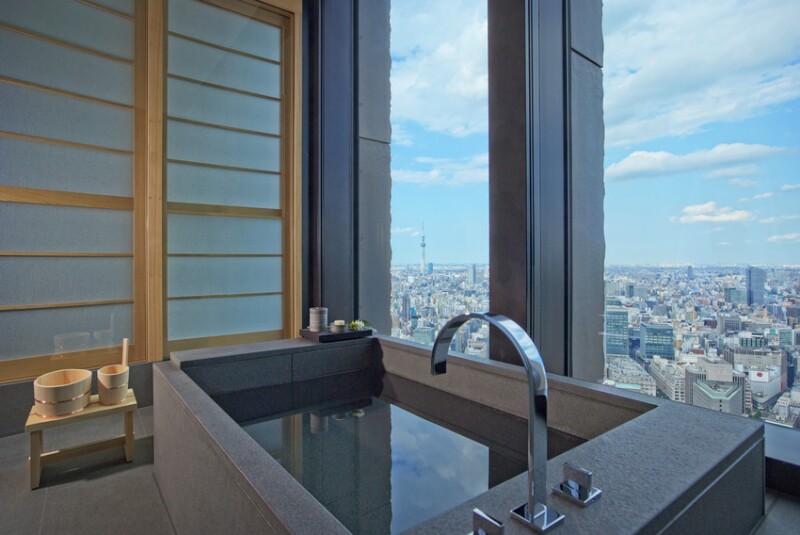
Aman, Tokyo
- Location: Tokyo
- Why we love it: A true urban resort with unmatched service in the heart of the city
- From $1,900
- Book now
Aman Tokyo delivers imaginative cultural experiences and superlative service to the center of Japan’s capital. Elevators open onto a 33rd-floor lobby with a soaring atrium, where the focal point is a seasonal ikebana flower arrangement, reflected in a shallow pool surrounded by rock gardens. The 84 guest rooms, inspired by traditional Japanese ryokans and designed by Singapore-based Kerry Hill Architects, are among the city’s largest entry-level accommodations. They’re a minimalist’s dream, with chestnut floors, sliding shoji screens, floor-to-ceiling windows framing city views, and large stone furo soaking tubs worth clearing an entire afternoon for.
Equally worthy of an extended exploration, the sprawling spa, which has onsen-style baths and a 98-foot pool, offers treatments that embrace the herb-based Kampo healing philosophy. Of the hotel’s dining options, the eight-seat Musashi by Aman is the most coveted reservation, with its omakase experience led by master chef Hiroyuki Musashi. Read Afar’s full list of top hotels in Tokyo. —Adam H. Graham
Aman Kyoto
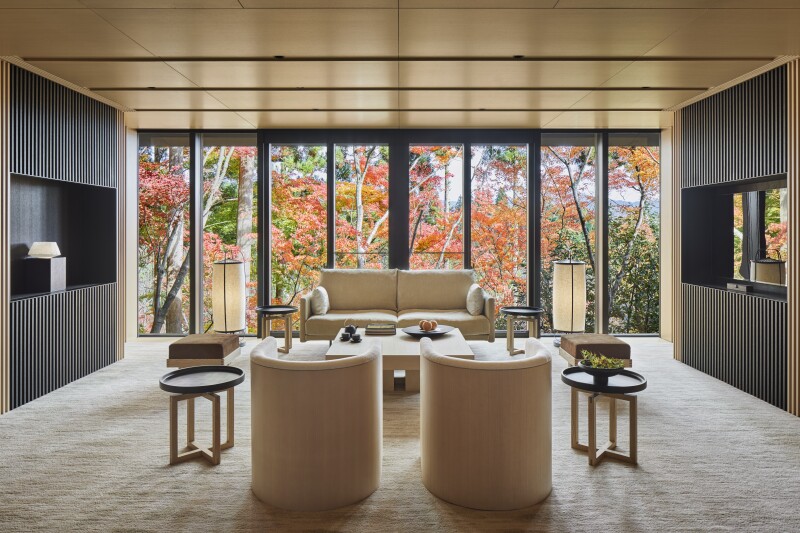
A suite at Aman Kyoto
Courtesy of Aman Kyoto
- Location: Kyoto
- Why we love it: Modern suites, forest bathing, and centuries-old trees turn a stay into a meditative retreat in the hills above the city
- From $2,600
- Book now
The location itself is a major selling point: 80 acres of serene forest in the foothills of Mount Daimonji, 30 minutes from Kyoto Station and five minutes by car from Kyoto’s famous Kinkaku-ji temple. Here, Aman Kyoto’s 26 modern suites stretch across an atmospheric riverbed shaded by trees. The forest is punctuated with native maples, cedars, and blue oaks, an ideal setting for forest-bathing excursions. Much of the property was built with materials from the surrounding woods: cypress soaking tubs, heated stone bathroom floors, and bamboo dividers with clean, minimalist lines and varied textures that offer a restorative setting. —AHG
Asaba
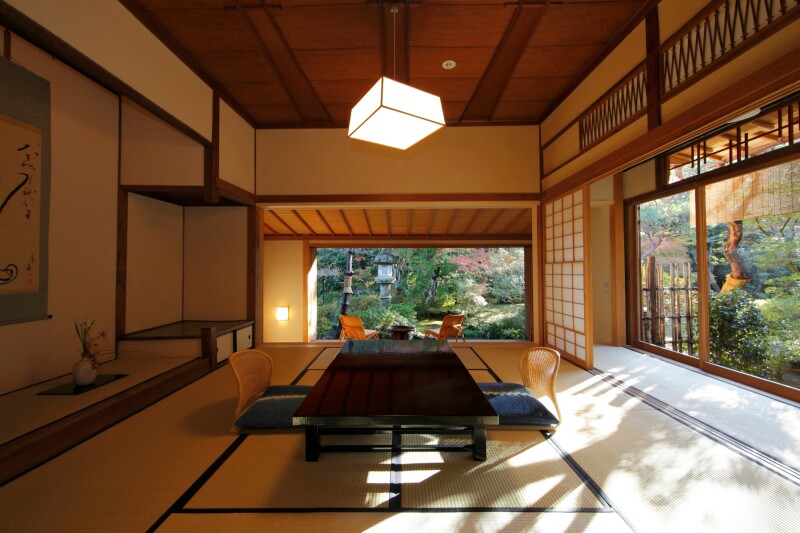
A garden view suite at Asaba
Courtesy of Asaba
- Location: Shuzenji, Shizuoka
- Why we love it: A 500-year-old ryokan complete with private onsen baths and seasonal kaiseki
- From $1,020
- Book now
Since 1494, the Asaba family has been welcoming guests to their esteemed namesake ryokan in Shuzenji, a hot spring town founded more than a millennium ago by Buddhist monk Kobo Daishi. A member of Relais & Châteaux, this intimate inn has 12 traditional guest rooms with tatami mat flooring, each overlooking a tranquil pond, a bamboo forest, and a historic Noh stage still used for occasional performances. Meals are served in-room while guests relax in yukata robes; a seasonal kaiseki dinner might feature black rice sushi with anago eel, corn tempura, and locally grown muskmelon. A traditional Japanese breakfast is also included. Every room has its own private onsen bath—just be sure to request a Western-style bed if preferred.
Azumi Setoda

Azumi Setoda was designed by Kyoto-based architect Shiro Miura.
Courtesy of Azumi Setoda
- Location: Ikuchijima Island
- Why we love it: Rooms open onto a private Zen-inspired outdoor space with cedar and cypress finishes and a balcony or garden view
- From $815
- Book now
Ikuchijima Island is famous for its lemons and Shimanami Kaido cycle route. And leave it to Adrien Zecha, founder of Aman Hotels, to create an entirely new reason to come here: Azumi Setoda, a retreat in the 149-year-old former home of the island’s prominent Horiuchi family. For the 22-room minimalist inn, which is in the town of Setoda, he hired Kyoto-based architect Shiro Miura. The retreat captures the languorous mood of the Seto Inland Sea while still offering access to the broader Seto Inland Sea art scene, including Naoshima, with its famous yellow pumpkin installation by Yayoi Kusama. Curved roof tiles, exposed beams, and a courtyard with a cherry tree offer a taste of Old Japan. The guest rooms are decorated with rice paper screens, cypress wood bathtubs, and gardens that face a landscaped courtyard, while the community bathhouse across the street is complimentary for guests. —AHG
Four Seasons Hotel Osaka
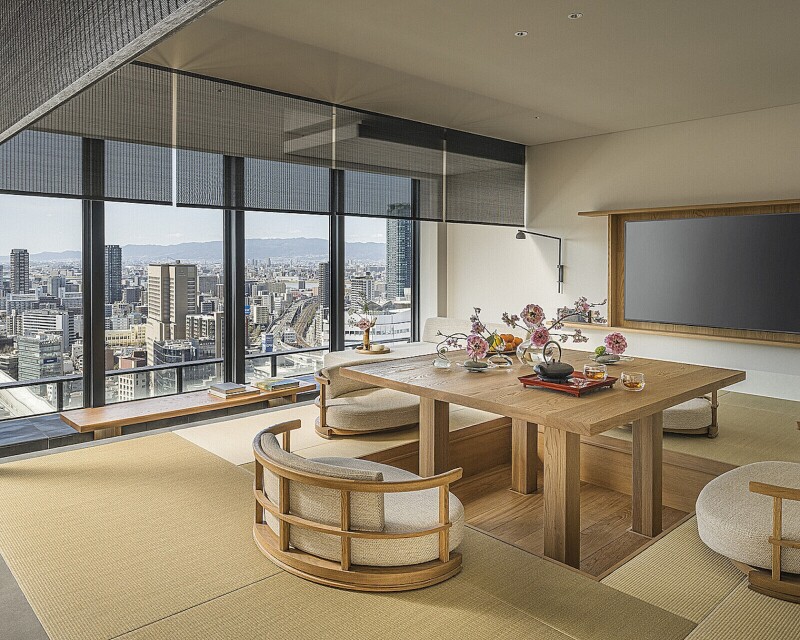
A guest room at the Four Seasons Hotel Osaka
Courtesy of the Four Seasons Hotel Osaka
- Location: Osaka
- Why we love it: Pilgrimage-worthy restaurants, rooms that evoke an urban ryokan
- From $850
- Book now
Think of the Four Seasons Hotel Osaka as two hotels in one: 154 rooms are Western-style, done up in muted tones inspired by spices, while the 28th floor houses Gensui, the city’s first urban ryokan, with 21 rooms lined with tatami mats and bedding from 450-year-old brand Nishikawa. On the 36th floor is a spa with ofuros (traditional baths), a sauna, and a 52-foot-long infinity pool that looks out over Osaka Castle in the distance. Four Seasons adds to the city’s impressive culinary lineup with Jiang Nan Chun, a Cantonese restaurant serving dim sum at lunchtime, and Sushi L’Abysse Osaka, a partnership between French chef Yannick Alléno and Japanese chef Itaru Yasuda, who pair French bites with unique twists on sushi and focus on low-waste ingenuity, such as wasabi peel simmered in soy sauce as a garnish for sashimi. See Afar’s full review of the Four Seasons Hotel Osaka. —Yukari Sakamoto
Fufu Kawaguchiko

Lake Kawaguchi is about three miles from the hotel.
Courtesy of Fufu Kawaguchiko
- Location: Kawaguchiko
- Why we love it: Every room has a private onsen with front-row views of Mount Fuji
- From $525
- Book now
It’s hard to top the Mount Fuji views at the contemporary-feeling Fufu Kawaguchiko, which opened in 2018 in the wine country town of Kawaguchiko, about two hours southwest from Tokyo by bullet train. The 32 guest rooms have giant glass windows that face serene Lake Kawaguchi, which lies about three miles away, and all have private balcony onsen tubs made with Fuji lava stone. The setting gets extra cozy with outdoor firepits and cashmere throws. The on-site restaurant pairs local wine with such seasonal dishes as Fuji Sakura Pork seared on lava stone with blueberry butter. —AHG
Hiiragiya

A guest room at Hiirayiga in Kyoto
Hiiragiya
- Location: Kyoto
- Why we love it: A storied ryokan with impeccable seasonal kaiseki and warm, generational hospitality
- From $820
- Book now
Established in 1818, this heritage Kyoto ryokan, easily one of Japan’s best, has been run like a sacred shrine by seven generations of the Nishimura family. Consider it a sanctuary where you can fully immerse yourself in the traditional Japanese inn experience—think low-slung lacquer tables, sliding fusuma doors, multicourse kaiseki meals, and pristine white shoji screens. Watch Japanese white-eye birds flit through the private camellia garden; bundle up in your yukata to dine in-room on abalone with miso egg yolk sauce and sea urchin chawanmushi (a savory egg custard) served on Kiyomizu ceramics; and drink a nightcap of sake before sinking into the freshly laid tatami mat in one of property’s 24 guest rooms. —AHG
Hoshinoya Taketomi

Hoshinoya Taketomi is located in Japan’s Okinawa region.
Hirofumi Inaba
- Location: Taketomi Island, Okinawa
- Why we love it: Traditional red-roofed villas, coral-sand paths, and starry skies make this Okinawan escape seem like another world
- From $700
- Book now
This small southern Okinawan island, part of the Ryukyu archipelago, is a tropical escape that’s home to Hoshinoya Taketomi. The resort’s 48 spacious villas feature red roofs carved with Shisa lion figurines, and they cluster around a breezy dune made of coral sand. Accommodations feature large soaking tubs, day beds designed so you can relish refreshing breezes, and stone walls that offer extra privacy. Kick back with a fresh shikuwasa juice, made from a native citrus, and enjoy plucky Okinawan music sessions and walks along the white-sand Kaji Beach, known for its star-shaped grains of sand. Cool down in the hot afternoon by doing laps in the long sunken oval pool, also alluring at night when the stars above Iriomote-Ishigaki National Park, an International Dark Sky Park, glitter overhead. —AHG
Hotel Cultia Dazaifu

Hotel Cultia Dazaifu sits next to the Tenmangu ̄shrine in Dazaifu.
Courtesy of Hotel Cultia Dazaifu
- Location: Dazaifu, Fukuoka Prefecture
- Why we love it: A beautifully restored traditional house steps from Dazaifu Shrine
- From $280
- Book now
Leafy temple town Dazaifu and its Tenmangū shrine are a quiet world apart from busy Fukuoka, Kyushu’s largest city, which is 30 minutes away by car. Located across the street from the 3,000-acre shrine complex is the 13-room, tile-roofed Hotel Cultia Dazaifu, comprising three 150-year-old buildings and manicured ponds; the shrine’s grounds with their 6,000 plum trees are just a short walk away. The former residence of the Yoshitsugu family, whose paintings and scrolls still decorate doors and walls, is connected by outdoor stone paths, each room screened off by sheer linen noren, some with private gardens, stone lanterns, and vaulted ceilings. All are accented with pops of modernity like Danish chairs and phone charging points. Don’t miss the hotel’s French fusion restaurant, which plates up dishes like sautéed red gurnard, Mitsuse chicken confit, and tender Hakata wagyu beef. —AHG
Hotel the Mitsui Kyoto, a Luxury Collection Hotel & Spa

The day lounge at Hotel the Mitsui Kyoto, a Luxury Collection Hotel & Spa
Courtesy of Hotel the Mitsui Kyoto, a Luxury Collection Hotel & Spa
- Location: Kyoto
- Why we love it: Centered on a centuries‑old courtyard garden with a hot spring spa
- Loyalty program: Marriott Bonvoy
- From $670
- Book now
Hotel the Mitsui Kyoto, a Luxury Collection Hotel & Spa, sits just across from the 17th-century Nijo Castle, a UNESCO World Heritage site. The grounds have belonged to the prestigious Mitsui family for centuries, lending the hotel both historical gravitas and a prime location. Its 160 spacious rooms, designed by André Fu, are arranged around a serene, curated garden.
A highlight is the thermal onsen pool, where guests can wear swimsuits—a rare concession in Japan, designed to make international visitors more comfortable. For a more traditional experience, book one of two private onsen baths. Dining is equally refined: Noted chef Tetsuya Asano, formerly of the Ritz Paris, helms the contemporary Franco-Japanese restaurant Toki, while Jean-Georges alum Fumio Yonezawa oversees Forni, the relaxed all-day Italian restaurant. History lovers will adore the rooms with direct views of Nijo Castle that offer a one-of-a-kind perspective. —YS
Kai Beppu

Kai Beppu offers a contemporary spin on the traditional Japanese ryokan.
Courtesy of Kai Beppu
- Location: Beppu, near Fukuoka
- Why we love it: A contemporary ryokan that embraces Beppu’s vibrant onsen culture—intimate hot spring dips included
- From $440
- Book now
Opened in 2021, the 68-room oceanfront Kai Beppu is in Beppu, 90 minutes from Fukuoka on Japan’s southernmost island of Kyushu. Designed by the celebrated Japanese architect Kengo Kuma, the structure is cloaked in sho sugi ban, a method of charring cedar so it doesn’t burn. Like many properties in Beppu, guests come for the restorative onsen, which takes many forms here: private balcony ofuro tubs, a landscaped ground-level onsen, and a hanging glassy infinity footbath, all high in hydrogen carbonate. Inspired by onsen towns, Kai Beppu has an in-house street food market and nightly performances of a rhythmic onsen jug band—a true “only in Japan” experience. —AHG
Kayotei Ryokan

A hostess greets guests at Kayotei Ryokan.
Jennifer Flowers
- Location: Yamanaka
- Why we love it: An elegant ryokan where everything feels rooted in nature and craftsmanship
- From $830
- Book now
There’s a reason why renowned international chefs like to visit Yamanaka, a hot springs town in Honshu’s seaside Ishikawa prefecture: to make a pilgrimage to Kayotei Ryokan, a 10-room private inn with onsen baths fed by natural mineral springs from the ground below it. Here, multi-course kaiseki meals are prepared mostly with the surrounding agricultural area’s organic produce, from the fish to the tofu. Every ingredient has a story: The rice maker uses ducks for pest and weed control in place of chemicals, and the midwinter nori, or seaweed, is harvested by brave souls who face the large waves and slippery rocks along the coast. Book one of the tatami-floored rooms with a private onsen, and be sure to check out the impressive collection of antique tansu scrolls and pottery throughout the retreat. —Jennifer Flowers
Mandarin Oriental, Tokyo

Mandarin Oriental, Tokyo is in the historic Nihonbashi neighborhood.
Courtesy of Mandarin Oriental, Tokyo
- Location: Tokyo
- Why we love it: A sanctuary in the sky where panoramic city and Mount Fuji views meet Michelin-starred dining and a world-class spa
- Loyalty program: Friends of M.O.
- From $630
- Book now
Occupying the top nine floors of the Nihonbashi Mitsui Tower, designed by renowned Argentine architect César Pelli, the Mandarin Oriental showcases postcard views of Mount Fuji to the west, Tokyo Skytree and the Sumida River to the east, and Tokyo Bay to the south. The hotel also turns to nature for its design inspiration. The property itself resembles a tree, with its entrance at the bottom of the tower representing the base; on the top floor, fabrics and carpets suggest leaves and branches, creating the feeling of a forest canopy. The 157 rooms and 22 suites were designed with such flourishes as bonsai trees and cherry blossom motifs. At the 37th floor spa, a signature “Totally Tokyo” treatment uses pine, bamboo, plum, green tea, and rice hulls to stimulate the senses and restore a sense of clarity. For dinner, choose between French, Spanish, and Italian restaurants.
Miyamasou
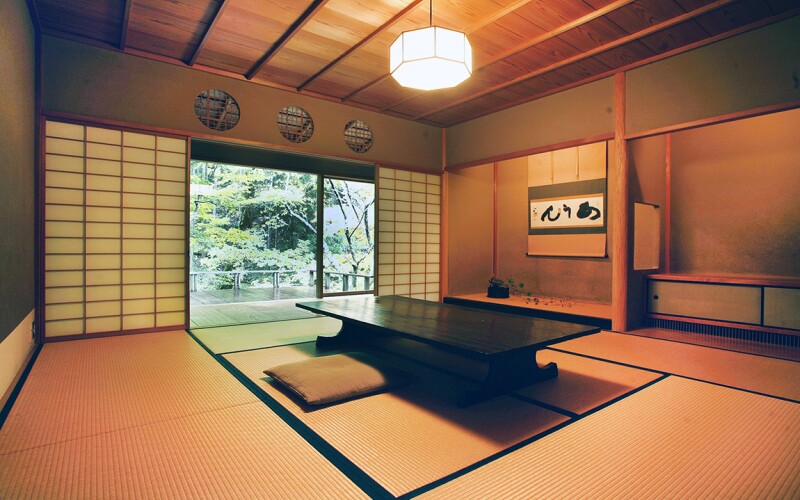
Miyamasou
- Location: Hanase, Kyoto Prefecture
- Why we love it: A four-room mountain retreat with private river-view bathtubs and world-class foraged kaiseki
- From $830
- Book now
Getting to Miyamasou is an experience unto itself. The hour-long drive from Kyoto on a narrow road passes Japanese cedar forests, small towns, temples, and shrines. The ryokan is famous for its two Michelin-starred, multicourse kaiseki dinners that showcase ingredients from the forest like gingko nuts and carp sashimi from a nearby river. After a hot bath in heated mountain spring water, guests dine in their yukatas in private rooms. The five immaculate tatami-floored accommodations feature sliding doors that lead out to terraces that hang over a rushing river, whose sound lulls guests to sleep at night. Book well in advance, given the inn’s diminutive size and outsize reputation. —JF
Nishimuraya
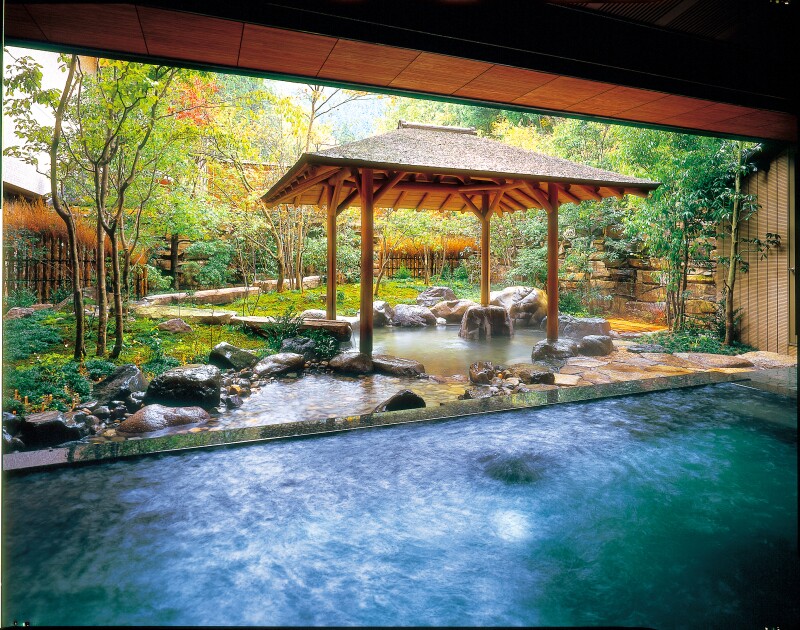
Nishimuraya Hotel Shogetsutei offers a classic Japanese onsen experience.
Courtesy of Nishimuraya Hotel Shogetsutei
- Location: Kinosaki Onsen
- Why we love it: An elegant ryokan in a storied onsen town with private forest-view baths, garden-facing rooms, and access to Kinosaki’s beloved seven public hot springs
- From $580
- Book now
The charming seaside town of Kinosaki Onsen, 2.5 hours northwest of Kyoto, is home to Nishimuraya, set along the willow-lined Otani-gawa River. The eighth-century town’s seven tattoo-friendly onsen each have their own individual appeal, and it’s common to hear the sound of wooden geta sandals on the pavement, worn by visitors who are hopping from onsen to onsen. Nishimuraya has two properties: the new Hotel Shogetsutei, and the older Honkan, which has 29 rooms built in the Sukiya style modeled after teahouses, with wooden terraces, sliding screens, and big windows facing Japanese gardens with sculpted shrubs and trees. The private onsen at Nishimuraya Hotel Shogetsutei are the most dramatic in town. They look out onto a 30-acre mountain forest and are ideal for guests who want more privacy.—AHG
Palace Hotel Tokyo

The living room of a Premier Suite at the Palace Hotel Tokyo
Courtesy of the Palace Hotel Tokyo
- What to expect: A modernist retreat next to the Imperial Palace
- Location: Marunouchi
- Loyalty program: Leaders Club (Leading Hotels of the World)
- From $630
- Book now
Only a moat separates you from the Imperial Palace at this stylish and modernist 284-room hotel with newly debuted Premiere Suites. Palace Hotel Tokyo dates back to 1961, but it was rebuilt from scratch and reopened in 2012 with 10 restaurants and a serene Evian Spa, replete with a high-tech fitness center and pool. Guest rooms and suites are done up in golds, creams, and light greens accented against dark, polished woods. But best of all are the outdoor balconies—a rarity in Tokyo.
The hotel’s range of curated activities is planned in-house and includes visits to sumo-wrestling events and contemporary art and architecture tours with local experts. The excellent Western breakfast at the Grand Kitchen offers a parade of French-inspired baked goods—raspberry croissants, perfectly puffy cream-filled doughnuts, and kugelhopf—along with duck confit, sausage, and pâté en croûte, which you can order on the leafy moat-side terrace. See Afar’s full list of the best hotels in Tokyo. —AHG
Park Hyatt Niseko Hanazono

A guest room at Park Hyatt Niseko Hanazono
Aaron Jamieson
- Location: Niseko (Hokkaido)
- Why we love it: An alpine sanctuary for both powder lovers and summertime adventurers
- Loyalty program: World of Hyatt
- From $310
- Book now
Park Hyatts in Japan are not only next level, they’re arguably the most Japanese of the international chains in the country, with generous touches of omotenashi throughout. Park Hyatt Niseko Hanazono’s 100 spacious rooms—including 28 suites, each with a private onsen—occupy four separate buildings and overlook the Annupuri range. The spa is surrounded by a stream and hemmed by birch trees. It includes a pool and a tattoo-friendly onsen—a rarity in Japan, where tattoos are often still found to be taboo.
Accommodations have deep soaking tubs, oversize beds, huge walk-in closets for storing bulky winter luggage, and sofas that convert to an extra bed for families or small groups. Close to a dozen restaurants are on offer, including a deli, sushi counter, cozy charcoal-grill robata, and French-Japanese teppanyaki, not to mention a private karaoke dining room. Onsite ski valet services pamper powder pilgrims, while an early-bird First Tracks program with the general manager himself gets you on the piste before it opens. Summer activities bookable onsite include everything from golf and zip-lining to cycling, rafting, and excursions to the National Ainu Museum, which showcases the culture of the Ainu people. —AHG
Patina Osaka

A junior suite at Patina Osaka
Courtesy of Patina Osaka
- Location: Osaka
- Why we love it: Historic elegance with cutting-edge wellness next to Osaka Castle
- From $660
- Book now
Opened in 2025 with interiors shaped by natural light, smooth woodwork, and organic textures, Patina Osaka is a modern retreat that sits between Osaka Castle and the commercial district of Umeda. The 221-room property includes minimalist suites with large soaking tubs, some with castle views. But the top draw may be its wellness center, which includes cryotherapy, oxygen chambers, forest-bathing rituals, and even poolside yoga in a dramatic glass-walled space. Five dining concepts include a rooftop Basque restaurant, a modern teppanyaki grill, and a tea lounge that nods to traditional Japanese teahouses. —JF
The Ritz-Carlton Nikko

A guest room at The Ritz-Carlton, Nikko
Courtesy of the Ritz-Carlton, Nikko
- Location: Nikko National Park, Tochigi Prefecture
- Why we love it: A lakeside sanctuary with an onsen, panoramic verandas, and world-class dining amid shrines and cedar forests
- Loyalty program: Marriott Bonvoy
- From $695
- Book now
Located in Nikkō National Park—home to marshy grasslands, dense forests, and sacred peaks—The Ritz-Carlton, Nikko offers 94 modern guest rooms, each with a veranda overlooking either Lake Chūzenji or Mount Nantai. The hotel is the first in the Ritz-Carlton portfolio to have an on-site hot spring, drawing its restorative waters from nearby Yumoto Onsen. Guests can unwind here after a day of cross-country skiing, guided nature walks, or temple visits led by local monks. Japanese and Western design influences blend throughout the property, from Nikko-bori woodcarvings and kumiko latticework to the use of Mashiko pottery in the restaurants. Dining highlights include local specialties like yuba (soy milk skin) and Tochigi wagyu beef, while Western menus are overseen by noted chef Kanji Kobayashi. —YS
Shisui, a Luxury Collection Hotel

An onsen in a suite at Shisui, a Luxury Collection Hotel, in Nara, Japan
Courtesy of Shisui, a Luxury Collection Hotel
- Location: Nara
- Why we love it: A modern sanctuary steps from Nara Park, with private outdoor onsen in the guest rooms
- Loyalty program: Marriott Bonvoy
- From $430
- Book now
On the eastern edge of Nara, just across from the grazing deer and greenery of Nara Park and the Mount Kasuga Primeval Forest, sits Shisui, a Luxury Collection Hotel. Opened in fall 2023 and redesigned by Kengo Kuma and Associates, the property centers around a low-slung wooden building originally constructed in 1922 as the Nara governor’s residence. Classical touches like a tiled roof gate and the tranquil Yoshikien garden—once part of a temple complex—imbue the hotel with a strong sense of place.
The 43 guest rooms are bright and serene, thanks to floor-to-ceiling windows that frame views of nearby Mount Wakakusa; select deluxe rooms and suites have in-room hot springs or open-air baths. Guests can also relax in the hotel’s spa and onsen, which uses volcanically fed waters, or take advantage of a 24/7 fitness center. Dining options include a sushi bar and Suiyou, a restaurant inspired by the Silk Road culinary traditions that shaped Nara during its era as Japan’s capital (710–794 C.E.). But the standout may be the elegant bar that spills into the garden—an ideal place to sip sparkling sake during the blue hour after a day spent exploring Nara’s UNESCO-listed treasures. —AHG
Simose Art Garden Villas

Simose Art Garden Villa was built by architect Shigeru Ban, a Pritzker Prize winner.
Courtesy of Simose Art Garden Villa
- Location: Hiroshima
- Why we love it: A floating art resort on the Seto Inland Sea
- From $1,600
- Book now
Simose Art Garden Villas, a new art complex and resort on the Seto Inland Sea in Otake, which is part of the Hiroshima prefecture, opened in April 2023 near Miyajima’s UNESCO-listed Itsukushima Shrine. The constellation of buildings are the work of Pritzker Architecture Prize winner Shigeru Ban. Four of the 10 villas date back to the 1990s and were rebuilt here this year and include Le Corbusier-inspired structures with colorful Mondrian panels. Five new waterside villas use an Austrian lightweight Kielsteg design featuring sliding wooden panels with key holes to let in light, while two rooms have deep cypress ofuru tubs. A glass-walled French restaurant and a mirrored museum featuring floating and glowing gallery modules, both designed by Ban, are open to the public, but museum access is exclusive and free to guests in the evenings and mornings. —AHG
Six Senses Kyoto

The living room of the Three Bedroom Penthouse Suite at the Six Senses Kyoto
Courtesy of Six Senses Kyoto
- Location: Kyoto
- Why we love it: An urban sanctuary where Heian-era elegance meets inner courtyards, a biohacking spa, and hyperseasonal cuisine
- Loyalty program: IHG One Rewards
- From $1,260
- Book now
Kyoto, a city of 1.5 million people known for its Buddhist temples, Shinto shrines, and ancient crafts traditions, is a perfect match for Six Senses, whose Kyoto property embraces its setting through thoughtful design and guest programming. Designed in soothing neutral tones by Blink Design Group, the 81 guest rooms and suites—the grandest is a sprawling Three Bedroom Penthouse—either face outward toward the city or inward to green gardens.
At the indoor-outdoor Sekki restaurant, the menu changes every two weeks, playing into the hyperseasonal approach that is evident in the veggie-focused, root-to-stem dishes that comprise more than half the offerings. Meanwhile, Sushi Oga Higashiyama, an outpost of a noted Osaka sushi restaurant, serves top-quality sushi with the red vinegar rice for which it’s famous. Read Afar’s full review of Six Senses Kyoto. —Kathryn Romeyn
Yagyu No Sho
- Location: Shizuoka
- Why we love it: A 15-room retreat with private and communal baths tucked within a bamboo forest
- From $640
- Book now
Tucked into a bamboo grove in the riverside village of Katsura Imperial Villa in Shizuoka prefecture, the modern-feeling Yagyu no Sho ryokan is built in the Sukiya-zukuri style, an architectural aesthetic once reserved for traditional teahouses. The 15 serene rooms act as a meditative retreat, with bell-shaped windows, sliding doors, and tatami mats—some with private outdoor spaces that overlook quiet ponds. The standout amenity here, though, is the onsen: several private baths filled with mineral-rich volcanic water and a large open-air communal bath that borders a mossy forest. —AHG
This article was originally published in May 2023. It was updated with new reporting in June 2025.









